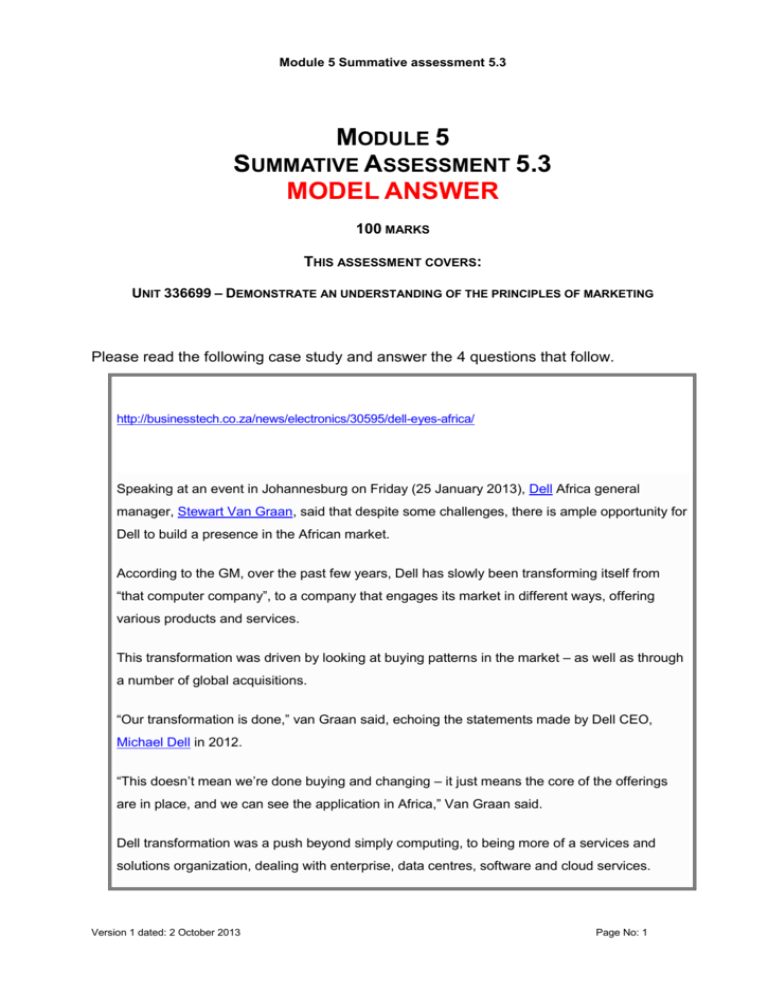Module 5 Summative 5.3 MODEL ANSWER
advertisement

Module 5 Summative assessment 5.3 MODULE 5 SUMMATIVE ASSESSMENT 5.3 MODEL ANSWER 100 MARKS THIS ASSESSMENT COVERS: UNIT 336699 – DEMONSTRATE AN UNDERSTANDING OF THE PRINCIPLES OF MARKETING Please read the following case study and answer the 4 questions that follow. http://businesstech.co.za/news/electronics/30595/dell-eyes-africa/ Speaking at an event in Johannesburg on Friday (25 January 2013), Dell Africa general manager, Stewart Van Graan, said that despite some challenges, there is ample opportunity for Dell to build a presence in the African market. According to the GM, over the past few years, Dell has slowly been transforming itself from “that computer company”, to a company that engages its market in different ways, offering various products and services. This transformation was driven by looking at buying patterns in the market – as well as through a number of global acquisitions. “Our transformation is done,” van Graan said, echoing the statements made by Dell CEO, Michael Dell in 2012. “This doesn’t mean we’re done buying and changing – it just means the core of the offerings are in place, and we can see the application in Africa,” Van Graan said. Dell transformation was a push beyond simply computing, to being more of a services and solutions organization, dealing with enterprise, data centres, software and cloud services. Version 1 dated: 2 October 2013 Page No: 1 Module 5 Summative assessment 5.3 The shift has specifically drawn attention to the enterprise market, where 30% of the company’s revenue is currently held within the mid-market channel (companies with under 3000 employees), which houses 40% of the profitability, Van Graan said. In the consumer game While the company has diversified with a definite aim at enterprise and corporate business, Van Graan emphasised that Dell has not forgotten it’s roots. “We’re still in the consumer game,” he said. “Retail is an important part of where we’re at.” Van Graan said that, while the current trends point to end-user computing stepping back – ultrabooks and tablets will continue to grow, and mainframes and servers won’t be disappearing any time soon. “We’ll participate where we see necessary [in end-user computing] – but we want to participate beyond that.” Eyes on Africa Dell currently operates in 27 countries across Africa, where Van Graan says the strategy for Dell is to find the balance between resource investment. According to Van Graan, the company is positioning itself as a “flexible” platform for midmarket companies – in that it aims to sell products and services which can be adjusted and suited to meet a company’s needs. “Our customers [in Africa] are telling us they have economic pressures…business is under pressure to deliver more.” Dell employs around 400 people to handle sales and handle operations in Africa – 280 of which are in South Africa, Van Graan said. Looking at East Africa, the GM conceded that due to economic and currency issues, “I think we’re under-invested there”. However, he noted that there was still big opportunity – particularly in school and government projects – to build presence in both East and West Africa. Version 1 dated: 2 October 2013 Page No: 2 Module 5 Summative assessment 5.3 Looking at South Africa, the country is leading the foray into application redesign and using new platforms, access to data, and devices coming out, Van Graan said. “Dell is intersecting into that.” Please answer the following 4 questions: 1. How would you analyse and discuss the main principles of marketing with specific reference to the case study above? (20 marks) 2. Can you determine the relationship between the strategic analysis process and the development of a marketing strategy and plan with specific reference to the case study above? (30 marks) 3. How would you evaluate the various market strategies that must be developed in reaction to the dynamic environment in which the organisation operates with specific reference to the case study above? (30 marks) 4. How would you analyse a marketing plan with specific reference to the case study above? (20 marks) ********************************************************************************* MODEL ANSWER The weighting of the marks must be 50/50 where the assessor determines where the key knowledge criteria have been expressed and described within the responses to equal approx 50% of the marks, and thereafter award the balance of 50% of the marks to the application of that knowledge by virtue of analyses, comparison, critique, or any other. The Blooms taxonomy rose may be utilised to identify the appropriate verb for the application of knowledge. Q1. The student must discuss the concept of marketing to reflect the roles of the various stakeholders in the supply chain and in the development of a marketing strategy and plan. The student must identify and assess the elements of a good marketing plan to determine their alignment to the supply chain environment. Version 1 dated: 2 October 2013 Page No: 3 Module 5 Summative assessment 5.3 The student must discuss and interpret a marketing plan in terms of its importance for the development of strategies and objectives for the various processes within the supply chain. The student must evaluate the marketing function in terms of its relationship with the various supply chain processes. The student must critically analyse the overall marketing process to reflect how it culminates into a marketing strategy and plan for the organisation. The student must assess the marketing plan against a specific a set of criteria to ensure that it addresses the business requirements. Q.2 The student must evaluate tools and techniques to determine their uses in the strategic analysis process. The student must explore the concept of macro environmental to indicate methods used for the analysis. The student must determine processes used to conduct a market/industry analysis for specific marketing purposes. The student must analyse customer management and customer management philosophies to reflect their impact on marketing plans and strategies. The student must assess basic processes and techniques of competitor analysis to indicate their effect on the development of a marketing strategy. The student must examine aspects of internal analysis for their uses in developing a marketing strategy (aspects include but are not limited to importance of the analysis, basic processes) Q3. The student must assess the concept of competitive advantage to determine the kind of strategies to be followed that would create sustainable competitive advantage. The student must evaluate the relationship between strategies and product life cycles to create awareness of the inter-relatedness of the two concepts. The student must identify and evaluate strategies for building relationships with key stakeholders to reflect their importance to the development of a marketing plan. The student must interrogate global marketing strategies to reflect their uses in the development of a marketing plan. Q4. The student must analyse a marketing plan to determine how the marketing strategies impact on the objectives of procurement, operations and distribution processes within organisations. The student must examine the concept of strategic marketing value mix variables to reflect how these are incorporated in the marketing strategy. The student must analyse a range of marketing plans to determine their relevance to a range of organisations and conditions. The student must indicate through an analysis of the strategies and plans the relevance to the core processes in the supply chain of the various marketing strategies. Version 1 dated: 2 October 2013 Page No: 4 Module 5 Summative assessment 5.3 Version 1 dated: 2 October 2013 Page No: 5








